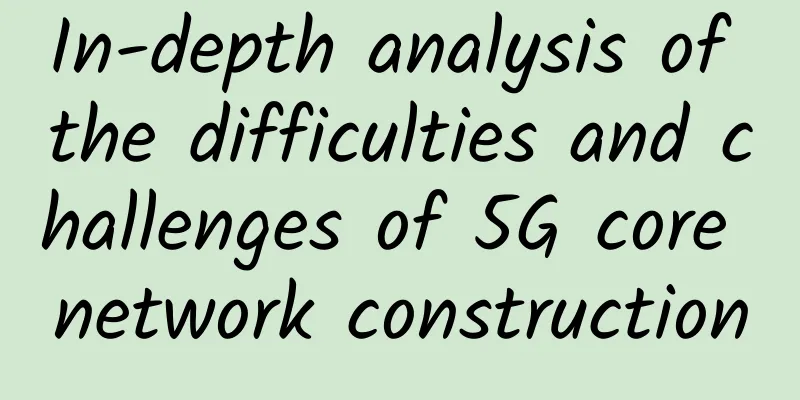In-depth analysis of the difficulties and challenges of 5G core network construction

|
At present, the core network is in a critical period of architecture transformation and business transformation. At the architectural level, the maturity of technologies such as NFV, CU separation, and edge computing has promoted the transformation of the core network architecture, with the control plane further centralized and the forwarding plane further decentralized. At the business level, 2G/3G business volume has declined rapidly, while 4G traffic, VoLTE, and the number of IoT users have grown rapidly. In the context of the gradual commercialization of 5G, in order to meet the needs of 5G commercialization, it is necessary to consider the construction and evolution strategy of the 5G core network in combination with multiple factors such as the commercial time point, the needs of 5G business scenarios in various provinces and regions, the maturity of standard technologies, and the maturity of equipment. Difficulties and challenges in building 5G core networks The 5G era is coming, and it will have a huge impact on all aspects of people's use of mobile technology. 5G is faster and has lower latency. In theory, 5G networks will open up new application scenarios in various fields, from smartphones to self-driving cars. However, such a complex 5G network faces many difficulties and challenges in construction. Challenges of Multi-network and Multi-service Access Integration Mobile communication systems have experienced rapid development from the first generation to the fifth generation. The real network has gradually formed a complex situation with multiple wireless standards. The long-term coexistence of multiple access technologies has become a prominent feature. The situation where the same operator has multiple networks of different standards, including 2G/3G/4G/5G and WLAN networks, will exist for a long time. How to efficiently operate and maintain multiple networks of different standards, improve competitiveness, continuously reduce operation and maintenance costs, and achieve energy conservation and emission reduction are problems that every operator must face and solve. Looking to 2020 and beyond, mobile Internet and Internet of Things services will become the main driving force for the development of mobile communications. How to achieve efficient dynamic management and coordination of multiple access networks while meeting the technical indicators and application scenario requirements of 5G is the main technical challenge of 5G multi-network and multi-service integration. The changes in the access network structure from 4G to 5G network are shown in Figure 1. CU (Centralized Unit): The non-real-time part of the original BBU will be separated and redefined as CU, which is responsible for processing non-real-time protocols and services. DU (Distribute Unit): The remaining functions of the BBU are redefined as DU, which is responsible for processing physical layer protocols and real-time services. Planning and O&M Challenges Brought by Network Virtualization (Cloudification) The full virtualization (cloudification) of 5G networks brings functional flexibility, but also brings many technical and engineering challenges. First, network virtualization makes cross-layer fault demarcation and positioning and subsequent upgrade processes more complicated and inefficient; second, the introduction of edge computing doubles the number of network elements, which will also lead to an exponential increase in construction and maintenance workload; finally, microservices and more customized services for users put forward extremely high requirements for service orchestration capabilities. Looking back at the historical practice of Network Function Virtualization (NFV), the current NFV transformation has not fully met the industry's expectations. Facing the 5G evolution, operators' networks still face three major challenges: First, the slow launch of new services. The delivery of large-granular packages based on network elements leads to a long development cycle, a large testing workload, and a large impact on upgrades. The software release cycle takes 3 to 9 months. Second, the operating cost is high. Management based on network elements leads to high costs for multi-network element deployment, docking, and operation and maintenance. At the same time, the number of 5G user-side sinking sites has increased by more than 10 times, resulting in a 5 to 10-fold increase in operation and maintenance costs. Third, the cost per bit is high. The cost per bit of COTS hardware has only decreased by 14% each year. Moore's Law has failed. The 8-fold increase in traffic in the 5G era will bring a 5-fold increase in hardware and energy consumption. To cope with the three major challenges, operators need to build a 5G simplified core network with extreme agility, simplified operation and extreme efficiency, so as to achieve real-time agility of services, network autonomy and cost per bit exceeding Moore's Law. Industry manufacturers have also reached a consensus and strived to achieve the following three points in response to the above requirements: First, extreme agility, based on microservices software architecture, the software has changed from large-granular delivery based on network elements to microservice granularity release, testing and upgrade, so as to achieve real-time agility of services and rapid launch, and the software release cycle has been shortened from half a year to less than one month, and the upgrade has changed from affecting millions of users to users without perception and without business interruption; second, extremely simplified operation, operation and maintenance has changed from being network-centric to network-centric, so as to achieve network autonomy. At the same time, the one-stop user plane has greatly reduced the supporting costs, and through unified operation and maintenance, the user plane can be plug-and-play, and stations can be added without adding people; third, extreme efficiency, through heterogeneous hardware comprehensive acceleration, the forwarding efficiency has been increased by more than 50%, and the cost per bit has exceeded Moore's Law. The 5G core network is closely related to the 4G core network. Some network elements need to be integrated and constructed to form a unified control plane and user plane anchor for 4G/5G to improve user experience, simplify network deployment and reduce costs. In recent years, the core network has started virtualization (cloudification) transformation and construction, such as virtualized EPC (Evolved Packet Core) and virtualized IMS. International leading operators have started large-scale commercial deployment of virtualization since 2016. China started a little later, but progressed very rapidly. Virtualized IMS has begun commercial use and virtualized EPC is also in the pilot process. By the end of this year, the network virtualization process of the three major operators will have major phased results. From the perspective of the core network NFV technology route, it will start with the IMS control plane, and the virtualization of the EPC network will be gradually realized in 2019. In addition, the construction of the telecom cloud unified resource pool is on the agenda, laying the foundation for the subsequent large-scale construction of 5G. In the 5G era, virtualization is a necessary basic technology. The 5G core network is a virtualized core network. This has become a broad consensus in the industry. Challenges of 5G Core Network Architecture The 5G multi-network convergence architecture will include multiple wireless access networks and core networks such as 2G/3G/4G/5G and WLAN. How to carry out efficient architecture design, such as the selection of core network and access network anchor points, while taking into account the complexity of network transformation and upgrade and the impact on the existing network are all issues that need to be addressed in network architecture research. 5G networking can support both SA and NSA modes. No matter what network architecture domestic operators eventually adopt, the pace of 5G commercialization will not slow down, and the scale of construction and investment will not shrink. However, in order to seize the 5G first-mover market, NSA may become the early network construction option for some operators, as shown in Figure 2. SA refers to the construction of a new 5G network, including new base stations, backhaul links, and core networks. NSA non-independent networking refers to the deployment of 5G networks using existing 4G infrastructure. 5G carriers based on the NSA architecture only carry user data, and their control signaling is still transmitted through the 4G network. Operators can determine the upgrade sites and areas based on business needs. They do not necessarily need complete contiguous coverage, and can use the current mature 4G network to expand 5G coverage. Due to the limited transmission power of mobile terminals, the coverage of 5G networks is mainly limited to the uplink. Then, through the joint networking with 4G (NSA), the coverage of 5G single stations can be expanded. However, since NSA does not require the construction of a new 5G core network and NSA requires the use of 4G wireless air interfaces (NSA wireless anchor points are in 4G), the existing 4G core network architecture and 4G air interfaces are not easy to meet the 5G requirements for latency and transmission reliability. If the NSA architecture is adopted in the initial stage of 5G construction, the 4G network and the 5G network will be tightly coupled, which will bring about problems such as site constraints and complex interoperability configuration. The subsequent evolution to SA will require multiple large-scale network adjustments.
In order to meet various new service requirements, the construction and planning of future 5G core network architecture must address the following issues. First, the core network access is independent. For fixed access and various wireless access, the core network should have a convergence function to ensure access independence. Ensuring access independence can reduce the complexity and inefficiency of the terminal access system and reduce functional redundancy. The second is the distributed architecture. The distributed architecture can improve the utilization of network resources and avoid problems such as inefficient data forwarding, single point failure, extended RTT, and traffic overload. The introduction of the distributed architecture is mainly used to overcome the defects of inefficient traffic paths and single point failures under the traditional EPC. By placing CGWs and eUCEs at the edge of the IP network, 5GC can provide efficient traffic paths, minimize signal latency, and provide better support for mobile edge computing. Under the traditional heterogeneous network architecture, traffic will be aggregated to an anchor point, while in the future 5G distributed architecture, traffic will be more flexibly distributed, which will increase throughput to thousands of times the current level. Third, the control plane and the user plane are completely separated. The core network should completely separate the data plane and the user plane through an open interface, which is conducive to the independent evolution and on-demand deployment of both parties. After the two planes are completely decoupled, data forwarding adopts the IP mode, the control plane function is placed in the eUCE and UCE, and the user plane function is placed in the CGW. The user plane and the control plane use an open interface to provide basic scalability and flexibility. With the support of the open interface, it is also very convenient to use virtualization technology for network slicing on this basis. Fourth, lightweight signaling support. For services such as IoT (Internet of Things), the core network should support lightweight signaling transmission and simplify related protocols. The connection-based approach of establishing a bearer channel before transmitting data in LTE will no longer be suitable for handling more and more service scenarios in the future. In order to cope with a variety of emerging usage scenarios, the signaling mechanism of the 5G core network should be expanded based on the concept of on-demand NAS. Whenever a user initiates a session, a suitable handler (appropriate non-access layer signaling) will be automatically generated according to the service the user needs to use. This mechanism can enhance network flexibility, reduce network signaling overhead, and support low-latency services. However, there is a problem with this mechanism. It can only summarize the usage scenarios and service types that can be imagined at this stage. With future development, more usage scenarios that are not currently foreseen will appear, which is a big challenge for the mechanism of constructing NAS information for known service types. The fifth is efficient mobility management. Efficient mobility management will lead to better resource utilization. The mobility management under EPC adopts a static anchor mechanism. All mobile terminals are connected to the operator network through a certain number of PGWs. When the user moves to a longer distance, the status of these PGWs in service will not change in a short time. This mechanism will cause the problem of inefficient traffic paths. In 5G, a dynamic anchor mechanism should be introduced based on distributed mobility management. The user establishes a session session1 on CGW1, and the eUCE will assign an IP address to it. If the user moves within the range of CGW2, the UE will reserve this IP address for CGW1 to prevent the user from returning to session1. However, if the user has already started a new session session2 on CGW2, the UE will be assigned a new IP address to change its local address. In 5GC, eUCE is responsible for intra-gateway delivery, UCE is responsible for inter-gateway delivery, and eUCE will dynamically send traffic path information to BS and CGW. In short, the evolution from EPC to 5GC must necessarily complete the evolution from static management to dynamic management. Data offload poses challenges to 5G core network slicing The data diversion mechanism in 5G multi-network convergence requires that user-plane data can be flexibly and efficiently transmitted in different access networks; minimize the impact on the underlying transmission of each access network; and make effective diversion level selections based on deployment scenarios and performance requirements, such as core network, IP or PDCP diversion. In addition to providing 2C (public customer) services, 5G networks will also meet the needs of 2B (industry user) services. In the early stage of 5G deployment, network deployment will be based on eMBB service requirements to meet the public broadband data service needs. In the later stage, mMTC and uRLLC service requirements will mainly be oriented towards vertical industries, industrial control, urban infrastructure and other fields. The network deployment areas and service perception requirements vary greatly, and major network adjustments or the addition of new carriers may be required. In response to more refined business needs, network slicing technology has to be introduced in 5G network construction. As the most discussed technology in 5G, network slicing is of great significance to 5G. Only by understanding the limitations of traditional core networks can we deeply understand the necessity of network slicing technology for 5G. First, with the rapid increase in the number and types of user terminals, the massive growth of traffic, and the continuous diversification of user needs, the current core network EPC, a traditional centralized network architecture, has gradually become difficult to handle the increasingly diverse service requirements. Second, EPC is a "one size fits all" architecture, which is "innately insufficient". For example, in EPC, the main function of the mobility management entity MME (Mobility Management Entity) is to manage the mobility of terminals, but not all user devices are mobile. For example, the communication between machine-to-machine (M2M) type sensors does not need to provide mobility support because the geographical locations of these devices are almost unchanged, and the architecture of the traditional core network will make many of the original designs completely useless when facing specific user groups. Third, many network elements on the traditional core network run on dedicated hardware devices and are severely coupled with software elements, which is very unfavorable for network programmability. Finally, since the functional division of each component in the current mobile core network is not clear, many user packets will be processed repeatedly in the process from eNodeB to SGW and then to PGW. The packet processing process is not simple. Therefore, its centralized architecture and high requirements for software and hardware make its deployment time long and the cost is also high. In the 5G era, the objects of mobile network services are no longer just mobile phone terminals, but various types of devices, such as tablets, fixed sensors, and vehicles. The application scenarios are also diverse, such as mobile broadband, large-scale Internet, and mission-critical Internet. The requirements that need to be met are also diverse, such as mobility, security, latency, and reliability. This provides a place for network slicing. Through network slicing technology, multiple logical networks are divided on an independent physical network, thus avoiding the construction of a dedicated physical network for each service. This is very cost-effective. The future network must transition from "one size fits all" to "one size per service" through network slicing technology. Although the use of network slicing can greatly improve network performance and service quality, the number of network slices is an important issue. Different slices cannot be set for each service. Too many slices will make maintenance and management difficult, while too few slices may result in a simple use case requiring two or more slices to meet its needs. The industry has not yet reached a consensus on the extent to which 5G slices can be sliced. Operators currently have two main options: one is to launch enterprise-optional network services based on the current package model; the other is to launch end-to-end customized network slices like the enterprise network market. The contradiction here is that simple slicing will still lead to network waste and it is difficult to meet the vertical needs of thousands of industries. Overly sophisticated sliced networks will lead to a surge in customization costs and operating costs. A more realistic model is likely to be that operators provide basic private network slices, and then industry agents and solution providers will provide further customized services to meet specific enterprise network needs. This also means that many new industrial chains will be created under the background of the 5G industry, and network and technology integration service providers in vertical industries may become the next new business outlet for 5G. At the same time, the sliced network model also brings challenges in operation and management. How enterprises operate and maintain the sliced networks they purchase, and how to deal with the relationship between the network and cloud computing and IT systems, this may also bring new market momentum, and some new roles or services are needed to fill these gaps. Whether it is the application of 5G slicing by traditional enterprises or the new industries emerging under the background of 5G slicing, most of them are still in the industry conception today. Someone must promote the implementation of these concepts and drive 5G towards a wide range of industry markets step by step. When facing the challenge of business offload, network slicing faces the following difficulties.
Core network transformation and reconstruction If 5G has opened the curtain on the digital transformation of operators, then the transformation of the network side is undoubtedly the most important part. Whether it is the challenge of OTT, the pressure of expanding vertical industries or increasing business revenue, the 4G EPC core network (NSA, non-standalone networking) built on the traditional architecture to deploy 5G can no longer meet the needs. Rapid customization, slice-based operations, and highly automated intelligent operation and maintenance have become new capabilities that must be possessed by the network in the 5G era. Therefore, based on virtualization (cloudification) technology and oriented to business, the 5G target network architecture deployed on the 5GC core network (SA, standalone networking) based on the SBA architecture has become the strategic goal of the world's leading operators and the overall demand for 5G commercial use. The transformation and reconstruction of the core network are mainly reflected in four aspects: first, based on SDN/NFV, enabling operator network reconstruction; second, adopting SBA and cloud-native architecture to enable network function agility; third, end-to-end network slicing technology to enable vertical industry development; fourth, using DevOps+AI as a means to build Zero Touch operation and maintenance to enable network operation and maintenance automation. Compared with the original network, the construction of the new 5GC core network faces four major challenges: network deployment, network functions, new business development, and coexistence of multiple standards. For 5G, 3GPP proposed SA and NSA architecture requirements in the R15 specification, and deployed 5G using the NSA Option 3 architecture. Since the core network still uses the traditional 4G EPC core network, the architecture and functions have not changed much. NSA can be supported based on traditional EPC upgrades or new virtualized EPCs. Although it has the advantage of rapid commercialization, there are relatively large challenges in the subsequent evolution to SA networks: First, NSA will bring large additional business costs, involving existing network upgrades and engineering transformation, and subsequent transformation to SA involves secondary transformation costs; second, upgrading from NSA to SA will face two major challenges: difficulty in terminal switching and difficulty in transformation. As the commercial time approaches, 5G network has reached a critical period of development. China Mobile has proposed three major design principles for 5G network architecture. The first is from rigid to soft, that is, from solid network to dynamic network, to achieve network resource virtualization, decoupling and service-oriented network functions. The second is IP and Internet-based mobile network, that is, to achieve intercommunication and integration with IT network, introduce Internet technology, and optimize network design. Finally, centralized intelligence and distributed processing, centralized intelligence - centralized functions, providing personalized value-added services for vertical industries, and distributed processing - mobile network functions close to users, improving network throughput and reducing latency. Using SDN/NFV technology to realize network cloudification, coupled with microservice design, this means that 5G network is truly open, service-oriented, and software-based, which is conducive to the integrated development of 5G and vertical industries. Judging from the current network situation, the two most likely evolution paths are as follows.
NSA uses Option 3x to achieve rapid deployment of NR. After the 5G core network is deployed, if the NR coverage is good, Option 7x is skipped. If the NR coverage is not good, Option 7x is used for transition, and LTE continues to serve as the anchor point. Regardless of the method adopted, the basic idea of evolution is to take LTE as the basis, gradually introduce 5G RAN and NGC, and focus on dual connection in the initial deployment. LTE is used to ensure coverage and switching, and 5G base stations are deployed in hot spots to improve the capacity and throughput of the system. Finally, it will gradually evolve until we fully enter the 5G era. Summarize Mobile communications are the country's key network infrastructure and an important engine for promoting national economic development and improving the level of informatization. The rapid deployment of 5G will help the development of industrial Internet, intelligent manufacturing, modern agriculture, smart cities and other aspects. However, there are many difficulties in the construction of 5G networks. It requires cooperation from the government, operators, communication infrastructure units, equipment manufacturers and other parties to achieve the goal of fast and efficient network construction. It should be said that network transformation represented by NFV/SDN technology has become an industry consensus. Not only are operators advancing in an orderly manner, but most equipment manufacturers are also actively embracing it, becoming an important driving force for network transformation. The 5G network that is about to be commercialized is closely related to NFV/SDN. Especially the core network, the network architecture determines the network competitiveness. Once the network is determined, it is difficult to adjust the architecture. As the control center of the telecommunications network, the core network is the brain in the network. 5G's massive terminals, ultra-low latency and ultra-high bandwidth, etc., all require the core network to respond and process quickly, and a new core network with a "smart mind" is needed. Therefore, the construction of 5G networks needs to adhere to the one-step network architecture. Building a new 5G core network is the key to reshaping the competitiveness of operators. 5G NSA mainly meets the needs of eMBB services in the early stage of 5G, and has the advantage of quickly experiencing 5G services. NSA Option 3 uses the traditional 4G core network, and there is no change in the software architecture. It can support NSA based on traditional equipment upgrades or new virtualized 4G core networks. Compared with the NSA EPC network, SA's 5GC is naturally built based on virtualization technology. By introducing MANO, slice/sub-slice management functions, etc., it meets the characteristics of slice on-demand customization, rapid generation, dynamic release, etc., and can better meet the needs of differentiated vertical industries. The introduction of service-oriented architecture in 5G is a brand-new technological innovation. It is completely open and decoupled at the service level, and is a top-down fully open architecture. This architecture is very conducive to operators to quickly deploy rich and varied services, and realize on-demand orchestration and upgrade through fine-grained services to meet the needs of long-term network evolution. |
<<: Review and Outlook of China's 100-day 5G Licensing
Recommend
What else will we look forward to in the communications industry in 2023?
Hello everyone, I am Xiaozaojun. The joyful and ...
Detailed explanation of TCP data segment format + UDP data segment format
TCP Message Format TCP (Transmission Control Prot...
Design Ideas for Billion-Level Traffic Gateway
[[384427]] This article intends to discuss gatewa...
HostYun Hong Kong Tsuen Wan AMD series VPS simple test
The day before yesterday, we shared the informati...
Fifteen best practices for a successful data center migration
Data center migrations are often complex and risk...
[Black Friday] RAKsmart top up $10 and get $10/top up $50 and get $30/top up $100 and get $50, VPS hosting starts from $0.99/month, cloud server starts from $2.49/month
RAKsmart Black Friday special offer is here, new ...
The arrival of 5G will trigger a larger-scale patent war, and the market size is expected to grow 120 times
Automakers are battling in court with Qualcomm, N...
A brief analysis of the 5G market breakthrough and development path of China's radio and television industry
[[405869]] As we all know, in the past three or f...
2018 China Enterprise Digital Transformation Seminar was held, Ruijie helped enterprises break through digital transformation
On August 24, the 2018 China Enterprise Digital T...
Application of multimodal algorithms in video understanding
1. Overview At present, video classification algo...
Huawei Cloud Private Cloud Solution Reaches New Success at the End of the Year Sixteen Words Connect Enterprises Now and in the Future
[51CTO.com original article] Huawei is a company ...
One of the biggest features of 5G is the security minefield
The 5G platform provided by operators has vulnera...
Is the backend a bit cumbersome? Go to the client!
Hello everyone, I am Xiaolin. Among Internet posi...
Mushroom CarLink launches an integrated Internet of Vehicles solution to provide users with a seamless "people-car life"
Several years ago, a company proposed a relations...
Cloud Native, the Golden Age of Developers
[[419048]] This is the best time for developers. ...









